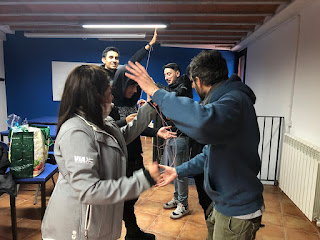Chicos, sigue un testimonio de uno de nustros antiguos alumnos de master.
Así podrán tener una idea do que hacemos en el CILS desde 2012,
" Antes del Máster siempre trabajé en despachos
de arquitectura, en los cuales se tenían en cuenta las demás ingenierías
involucradas en los proyectos, sin embargo, no se profundizada en ellas.
El máster no solo me ayudó a entender y
aplicar mejor los conceptos de diseño sostenible, sino a tener noción de cómo
las ingenierías también pueden contribuir al ahorro de energía y generar un
proyecto cuya construcción y operación sea más amigable con el medio ambiente.
No solo a través de clases sino también de visitas y conversaciones con
profesores de diversas nacionalidades y amplia experiencia en la materia. La
convivencia con compañeros de diversas partes del mundo también tiene una gran
valor agregado y cosidero que sumó mucho en mi crecimiento profesional.
El máster también me sirvió como motivación
principal para lograr la acreditación internacional de "LEED Green
Associate", otorgada por el USGBI (Green Building Certification
Institute". Fui una de los primeros profesionales en lograrla en Perú y es
una certificación reconocida internacionalmente. A la fecha en Perú hay
alrededor de 30 edificios con certificación LEED y he tenido la suerte de poder
participar en dos de ellos.
Actualmente me encuentro trabajando, desde
hace más de 4 años en la empresa "Constructores Interamericanos SAC"
. La empresa es una Inmobiliaria / Constructora parte del Grupo Fierro (Capital
español) con operaciones en Perú, Colombia y Venezuela.
Ocupo el puesto de Jefe de Proyectos en el
área de Gerencia de Desarrollo. Estoy a cargo de la revisión y optimización de
todas las especialidades que comprenden los proyectos de Vivienda, Oficina,
Comercio e Industria.
Para poder ocupar este puesto ha sido de mucha
ayuda lo verificado en el Máster pues demanda conceptos de ahorro de energías y
criterios de diseño amigables con el medio ambiente. También la empresa me
brindó la responsabilidad de elaborar y ser co-autor de la "Guía de
construcción verde" para procesos de construcción amigables con el medio
ambiente en nuestros proyectos.
Finalmente, considero importante mencionar que
siempre que lo requiero puedo consultar las guías de estudio con las que se
impartían las clases ya que luego de más de 5 años de terminado el programa sigo
encontrando herramientas que me ayudan.
Saludos "
Sergio Saavedra Sheen - Peru - MASEE





























